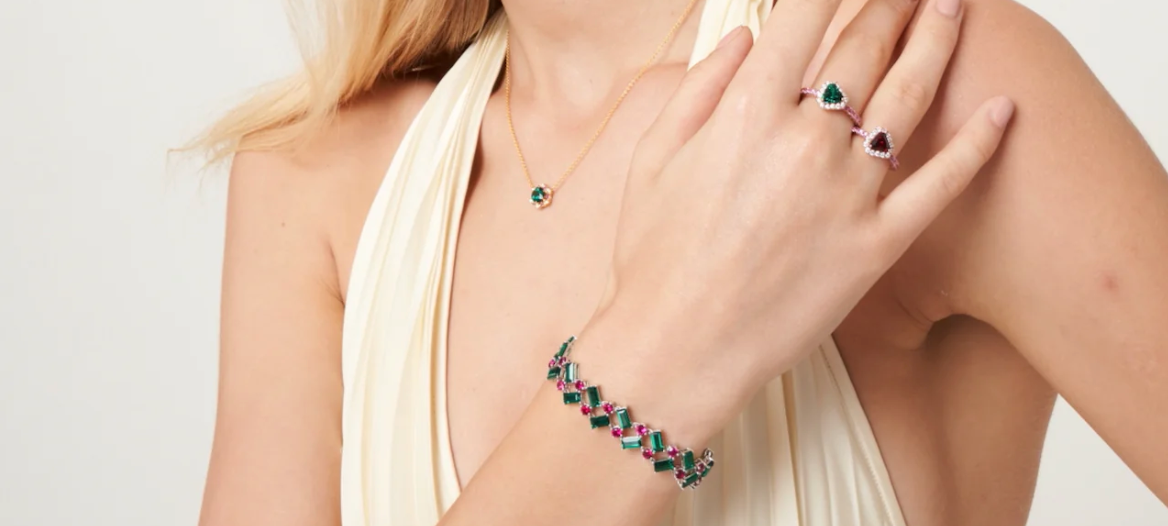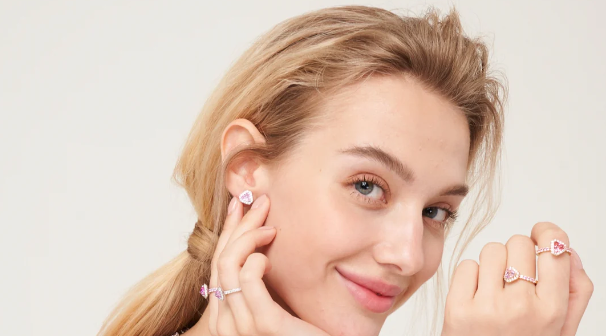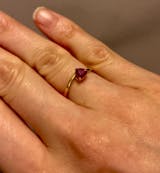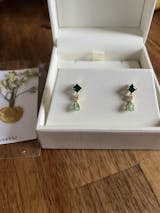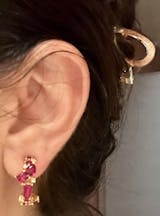
Eco-Friendly Elegance: Lab Grown Diamond Necklaces for the Conscious Consumer
In a world of sustainable luxury and elegance, diamonds have long reigned supreme. Today, as the world is placing more importance on eco-conscious values, lab-grown diamonds are gaining prominence. Lab grown diamond necklaces, ethically produced jewellery symbolise a shift toward eco-friendly elegance, making them a preferred choice for the conscious consumer.
What are Lab-Grown Diamonds?
Lab-grown diamonds are genuine diamonds created in controlled laboratory environment. This innovative process replicates the natural conditions under which diamonds are formed. These cultured diamonds are identical to natural ones in appearance, chemical composition, and physical properties, marking a significant achievement in sustainable jewellery making.
So, how are diamonds created in a lab? There are two main methods used in their production: High Pressure-High Temperature (HPHT) and Chemical Vapor Deposition (CVD). The HPHT method involves placing a small diamond seed in a carbon-rich environment, subjecting it to extreme temperatures (around 1500°C) and pressures (1.5 million pounds per square inch), thereby forming a diamond around the seed. In contrast, the CVD process starts with a diamond seed in a chamber filled with carbon-rich gas like methane and hydrogen. The chamber is heated to several hundred degrees Celsius, causing the gas to break down and carbon atoms to build around the seed, gradually forming a diamond.
These lab-grown diamonds are chemically, physically, and optically identical to their mined counterparts, featuring the same hardness, fire, scintillation, and sparkle.
Pristi White Gold Necklace Diamond & Yellow Sapphire
The Environmental Impact of Diamond Mining vs. Lab-Grown Diamonds
Traditional diamond mining is notorious for its extensive ecological impact. The process of extracting diamonds from the earth involves large-scale operations that significantly alter landscapes and ecosystems.
Here are some key aspects of the ecological damage caused by diamond mining:
- Land Degradation: Diamond mining involves extensive soil and rock excavation, causing significant land degradation, topsoil loss, and agricultural land destruction. It also changes landscapes, creating sinkholes and increasing flood and landslide risks. Often, this irreversible damage leads to permanent ecosystem and species loss.
- Water Pollution: Mining contaminates nearby water sources with chemicals and sediments, harming aquatic life and reducing water quality for communities. It also produces toxic wastes and acid mine drainage, releasing acidic water that damages ecosystems and pollutes surface and groundwater.
- Deforestation: In many cases, diamond mining involves clearing large areas of forests. This deforestation not only destroys habitats for wildlife but also contributes to the loss of biodiversity. Toxic contamination that threatens various species, as seen in Peru's rainforests and the Krugersdorp Game Reserve.
- Ethical Concerns: Mining activities are marred by serious ethical issues, including hazardous working conditions and human rights violations like forced labor and child labor. These practices often lead to community disruption and widespread impoverishment.
- Carbon Footprint: The heavy machinery used in diamond mining and the overall process contribute significantly to carbon emissions, exacerbating the issue of climate change.
In contrast, the production of lab-grown diamonds generally requires less land disturbance and can be powered by renewable energy sources, significantly reducing its environmental impact. Ethically and environmentally, lab-grown diamonds present a more sustainable choice. They avoid the extensive environmental damage associated with diamond mining and assure a conflict-free origin, making them a popular choice for eco-conscious consumers. By combining traditional diamond beauty with modern technology and ethical considerations, lab-grown diamonds represent a significant advancement in sustainable jewellery making.
Why Choose Lab-Grown Diamond Necklaces?
Apart from their sustainable and ethical appeal, lab-grown diamond necklaces are also renowned for their accessibility and quality.
Consumers who opt for lab-grown diamonds are embracing high-quality and visually stunning jewellery and supporting more sustainable and humane industry practices.
Lab grown diamonds often come at a more accessible price point, making luxury more attainable. They cater to a growing demographic of consumers who seek high-quality and visually stunning options.
Advances in technology have enabled the creation of lab-grown diamonds in various cuts and designs, rivaling their mined counterparts in brilliance and beauty. The choice of a lab-grown diamond necklace is not just a fashion statement but a reflection of an informed, responsible, and style-conscious consumer, demonstrating that luxury and responsibility can coexist harmoniously.
Juvetti’s Collection of Lab-Grown Diamond Necklaces
Juvetti, at the forefront of this sustainable luxury movement, offers an exquisite collection of lab-grown diamond necklaces. Each piece in the collection is a blend of innovation, craftsmanship, and ethical beauty. From classic solitaires to intricate designs, Juvetti’s necklaces cater to various tastes, ensuring that every customer finds a piece that resonates with their style and values. These necklaces are not just accessories; they are statements of a commitment to a greener, more sustainable future.
How to Choose the Perfect Lab-Grown Diamond Necklace
Selecting the perfect lab-grown diamond necklace involves considering several factors. Here’s a step-by-step guide to better help you pick the right laboratory-grown diamond necklace.
Consider whether you prefer a classic, modern, or unique design. Lab grown diamond necklaces come in various styles, from simple solitaires to intricate patterns. If you lean towards timeless beauty, consider a solitaire necklace featuring a single, prominent lab-grown diamond. For a more modern and bold statement, look for necklaces with unique settings or intricate designs incorporating multiple lab-grown diamonds.
For classic elegance, the Ori Small Pendant Necklace in Diamond Set in White Gold gives the perfect look!
The setting of a diamond necklace is crucial as it not only secures the diamond but also enhances its beauty and overall appeal. There are several setting types, each offering a different look and level of security for the diamond.
- Prong Setting: Ideal for maximiหing the diamond's brilliance by allowing ample light exposure.
- Bezel Setting: Offers a sleek and modern look with the added benefit of protecting the diamond.
- Pave Setting: Features small diamonds set closely together for a sparkling effect.
- Halo Setting: Features a central diamond surrounded by a 'halo' of smaller diamonds which enhances the overall sparkle and makes the central stone appear larger.
The metal used in the setting can greatly impact the necklace's look. Popular choices include:
- White Gold or Platinum: Ideal for those who love a timeless look, these metals are known for their sleek, classic appearance.
-
Yellow or Rose Gold: These options bring a warm hue to the jewellery, offering a vintage or romantic touch to the design.
For an everyday wear, opt for simple, sturdy designs that are comfortable and versatile. If you’re going to attend special events, choose statement pieces to add luxury and sophistication to formal attire.
Take advantage of Juvetti’s diverse range, which offers options suitable for various styles and occasions, ensuring that you find a piece that resonates with your personal style and the intended purpose of the jewellery.
By following these steps, you can confidently select a lab-grown diamond necklace that not only complements your style and occasion but also aligns with your values of sustainability and ethical fashion.
Evaluating Quality and Certification
When it comes to lab grown diamonds, quality and certification are paramount. Here’s what to look for:
- Certifications: When selecting a lab-grown diamond, it's crucial to look for a certification from a recognised gemological laboratory, such as the Gemological Institute of America (GIA), International Gemological Institute (IGI), or the American Gem Society (AGS). These certifications authenticate the diamond's origin and provide detailed information about its characteristics. It's important to note that these labs typically offer certification for diamonds that are 0.15 carats or larger. This threshold ensures that the characteristics of smaller diamonds, such as cut, color, clarity, and carat weight, are thoroughly assessed and documented.
- 4Cs of Diamond Quality: Familiarise yourself with the 4Cs - Cut, Color, Clarity, and Carat. These are the global standard for assessing the quality of diamonds:
- Cut: Refers to how well the diamond has been cut and shaped, affecting its symmetry, brightness, and overall appearance.
- Color: Lab grown diamonds, like natural ones, come in various shades. Colorless diamonds are often more desirable and graded from D (colorless) to Z (light color).
- Clarity: This measures the cleanliness or clearness of the diamond. It includes internal features (inclusions) and surface defects (blemishes).
- Carat: Carat refers to the diamond's weight, with one carat equating to 200 milligrams. Larger diamonds are rarer and thus more valuable.
- Ethical Production: Confirm that the diamond is ethically produced. Most lab grown diamond producers emphasise sustainable and ethical practices, but it's good to do your research.
Caring for Your Lab-Grown Diamond Necklace
Caring for your lab-grown diamond necklace is essential to preserve its sparkle and longevity, ensuring that it remains a treasured piece in your collection. Regular maintenance is key. Start by gently wiping the necklace with a soft, lint-free cloth after each wear. This simple action helps remove oils and residues that accumulate from skin contact and environmental exposure.
For a deeper clean, occasionally soak the necklace in a mild soap and water solution, using a soft brush to gently scrub around the diamond setting. It is crucial to avoid harsh chemicals, such as chlorine or abrasives, which can damage both the metal setting and the diamond itself. After cleaning, rinse the necklace in clean water and dry it thoroughly with a soft cloth.
Storing your lab-grown diamond necklace properly is equally important to prevent scratches and damage. When not in use, place the necklace in a separate pouch or dedicated jewellery box with soft lining. This separation is vital to protect it from coming into contact with other pieces, which could lead to scratches or damage to the delicate setting.
Additionally, it’s advisable to avoid wearing your diamond necklace during activities that could expose it to physical damage or extreme temperatures, such as sports, gardening, or environments with drastic temperature changes.
By following these care guidelines, your lab-grown diamond necklace will retain its stunning beauty and symbolise sustainable luxury for many years to come.
The Future of Sustainable Luxury: The Role of Lab-Grown Diamonds
Lab-grown diamonds are not just a passing trend; they are a significant shift in the luxury goods industry. As awareness of environmental issues and ethical practices grows, consumers increasingly seek sustainable options. The demand for eco-friendly luxury items like lab-grown diamonds is gaining momentum. Lab-grown diamonds, with their lower environmental impact and ethical production, are at the forefront of this shift. They represent the future of luxury - where elegance and eco-consciousness go hand in hand.
The way these diamonds are produced, with a keen eye on reducing environmental impact and upholding ethical labor standards, is shaking up the old perceptions of luxury. This approach paves the way for a future where sustainability is not just an afterthought but a fundamental aspect of crafting high-end items. As consumers increasingly make choices that reflect their personal values, lab-grown diamonds are leading the charge. They represent a new standard in the luxury world, where elegance seamlessly blends with environmental awareness. This emerging trend is poised to inspire more innovations in sustainable luxury, redefining what it means to be both opulent and conscientious in the modern age.
Conclusion
Lab-grown diamond necklaces are more than just jewellery; they are a choice for a better future. By choosing these sustainable gems, consumers support ethical practices, reduce environmental impact, and still indulge in the timeless elegance of diamonds. Juvetti’s collection offers the perfect blend of luxury, conscience, and style, empowering consumers to make choices that align with their values without compromising beauty. Embrace eco-friendly elegance and join the movement towards a more sustainable and conscious luxury.
FAQs
Are lab grown diamonds real diamonds?
Yes, lab grown diamonds are real diamonds with the same physical, chemical, and optical properties as mined diamonds.
How do lab grown diamonds compare in quality to mined diamonds?
Lab grown diamonds match the quality of mined diamonds, often with fewer impurities and defects.
Why are lab grown diamonds considered more ethical?
They are created without the environmental and ethical issues associated with traditional diamond mining.
Can lab grown diamond necklaces be customised?
Yes, they offer extensive customisation options, allowing for unique and personal designs.
Will lab grown diamonds hold their value over time?
While the resale value can vary, lab grown diamonds are cherished for their beauty and ethical attributes, making them a valuable addition to any collection.















